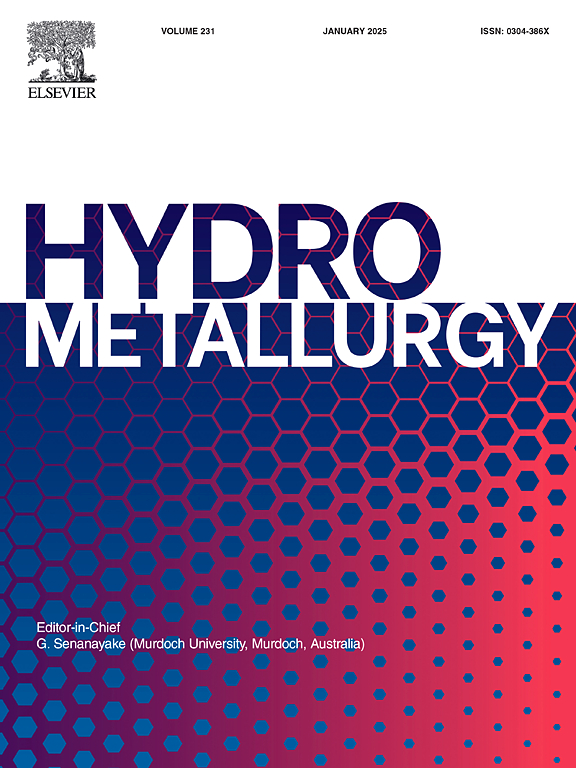Investigation of hydrodynamics behavior in a gas-agitated disc and doughnut column for solvent extraction with application to impurity removal from mixed nickel‑cobalt hydroxide precipitate
IF 4.8
2区 材料科学
Q1 METALLURGY & METALLURGICAL ENGINEERING
引用次数: 0
Abstract
Controlling the dispersed phase droplet size within a reasonable range in the extraction column is crucial for enhancing mass transfer efficiency. Traditional high energy-inputs may result in excessive droplet fragmentation in low interfacial tension systems, posing significant challenges in intensifying the extraction process. This work proposes a novel gas-agitated technology to prevent excessive droplet fragmentation. Three extraction systems, with different physical properties, were selected for the experiment: 4, 30, and 50 % (v/v) TBP/kerosene-Water. Within the range where the dispersed phase and continuous velocities vary from 1.47 × 10−3 m/s to 2.51 × 10−3 m/s, and the gas velocity ranges from 2.36 × 10−3 m/s to 1.18 × 10−3 m/s (note the order of these velocities should be clearly distinguished if they represent different phases). The droplet size (d32), dispersed-phase holdup (xd), and gas holdup (xg) were investigated in a disc-and-doughnut column (DDC) equipped with a gas-input unit. The aim of this investigation was to understand the influence of gas energy-input on hydrodynamic parameters. The results show that gas-input can expand flooding limitation, and it has the ability to break-up droplets, reducing droplets diameter from 3.6 mm to 1.2 mm approximately, while effectively preventing excessive fragmentation. The value of xd initially decreases and then increases with the increase in gas velocity. Within the operating gas velocity range, the value of xg increases from 9.7 % to 22.3 %, but without the effect of two-phase velocity. The modified correlations for droplet diameter, dispersed phase holdup, and gas holdup in the gas-agitated extraction column were proposed with deviations of 11.6 %, 15.9 %, and 4.3 %, respectively. These findings are useful to strengthen the low interfacial tension extraction processes in the future. A preliminary study was conducted to investigate the mass transfer enhancement in a gas-agitated column with a typical low interfacial tension extraction system (P204/kerosene-acidic solution of nickel cobalt complex hydroxide). Under similar conditions, extraction with P204/kerosene shows the improvement of metal extraction efficiency with an increase in gas velocity for agitation. The extraction efficiencies of Mg2+ and Mn2+ were significantly higher when gas-agitated was employed compared to pulsation. This finding indicates that gas-agitated column with moderate energy input is more suitable for low interfacial tension systems.
气体搅拌圆盘和环形塔溶剂萃取流体动力学行为的研究及其在去除混合镍钴氢氧化物沉淀中的应用
将萃取塔内的分散相液滴粒径控制在合理范围内是提高传质效率的关键。在低界面张力体系中,传统的高能量输入可能导致液滴过度破碎,给强化萃取过程带来重大挑战。本文提出了一种防止液滴过度破碎的新型气体搅拌技术。选取物理性质不同的三种萃取体系:4、30和50% (v/v) TBP/煤油-水。在这个范围内,分散相和连续相的速度从1.47 × 10−3 m/s到2.51 × 10−3 m/s,气体的速度从2.36 × 10−3 m/s到1.18 × 10−3 m/s(注意,如果它们代表不同的相,这些速度的顺序应该清楚区分)。在配备气输入装置的圆盘-甜甜圈柱(DDC)中研究了液滴尺寸(d32)、分散相含率(xd)和气含率(xg)。本研究的目的是了解气体能量输入对水动力参数的影响。结果表明:注气可以扩大驱油限制,具有破碎液滴的能力,将液滴直径从3.6 mm左右减小到1.2 mm左右,同时有效防止了过度破碎;随着气速的增加,xd值先减小后增大。在工作气速范围内,xg值从9.7%增加到22.3%,但不受两相速度的影响。提出了气搅拌萃取柱中液滴直径、分散相含率和气含率的修正关系式,偏差分别为11.6%、15.9%和4.3%。这些发现对今后加强低界面张力萃取工艺具有重要意义。采用典型的低界面张力萃取体系(P204/煤油-镍钴络合氢氧化物酸性溶液),对气体搅拌柱的传质强化进行了初步研究。在相同条件下,用P204/煤油进行萃取,随着搅拌气速的增加,金属萃取效率提高。与脉动法相比,气体搅拌法对Mg2+和Mn2+的萃取效率显著提高。这一发现表明,中等能量输入的气体搅拌柱更适合于低界面张力体系。
本文章由计算机程序翻译,如有差异,请以英文原文为准。
求助全文
约1分钟内获得全文
求助全文
来源期刊

Hydrometallurgy
工程技术-冶金工程
CiteScore
9.50
自引率
6.40%
发文量
144
审稿时长
3.4 months
期刊介绍:
Hydrometallurgy aims to compile studies on novel processes, process design, chemistry, modelling, control, economics and interfaces between unit operations, and to provide a forum for discussions on case histories and operational difficulties.
Topics covered include: leaching of metal values by chemical reagents or bacterial action at ambient or elevated pressures and temperatures; separation of solids from leach liquors; removal of impurities and recovery of metal values by precipitation, ion exchange, solvent extraction, gaseous reduction, cementation, electro-winning and electro-refining; pre-treatment of ores by roasting or chemical treatments such as halogenation or reduction; recycling of reagents and treatment of effluents.
 求助内容:
求助内容: 应助结果提醒方式:
应助结果提醒方式:


